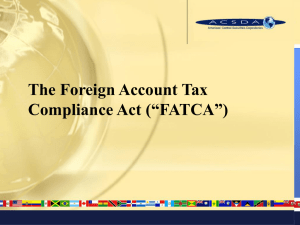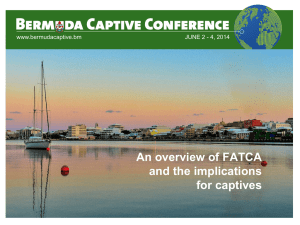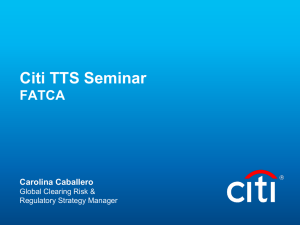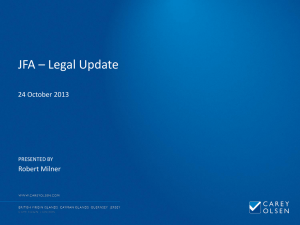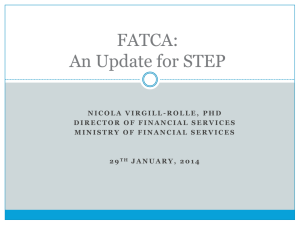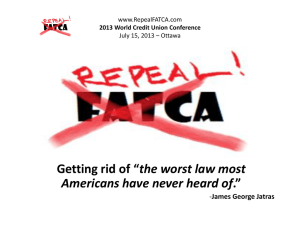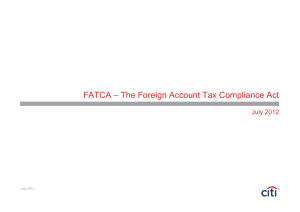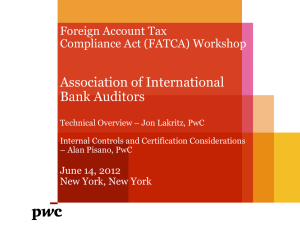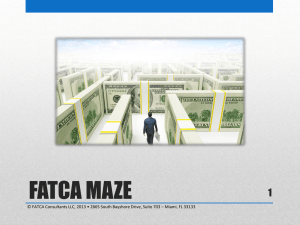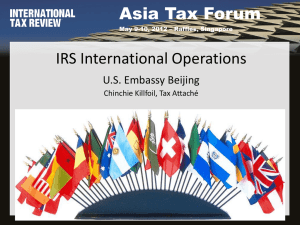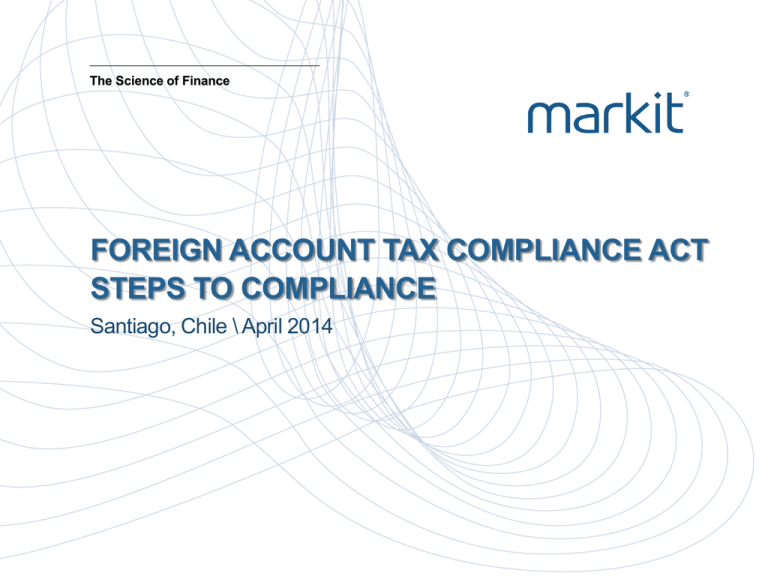
The Science of Finance
FOREIGN ACCOUNT TAX COMPLIANCE ACT
STEPS TO COMPLIANCE
Santiago, Chile \ April 2014
FATCA – Steps to Compliance
AGENDA:
Legislative Update
Steps to Compliance (contd.)
FATCA & Custodians
Part III – Registration
Steps to Compliance
Part IV – Withholding & Reporting
Part I – Entity Analysis
IGA Models
Markit’s FATCA Service Bureau
Questions
Chilean IGA
Part II – Due Diligence
Classification & Validation
Document Collection
\
2
The Science of Finance
FATCA LEGISLATIVE UPDATES
FATCA – Steps to Compliance
NO EXTENSION OF FATCA EFFECTIVE DATE: Treasury adamant that July 1 2014 FATCA
effective date would not be changed.
ELUSIVE FINAL FORMS W-8: IRS has now released both Form W-8BEN and W-8BEN-E
FORM W-8BEN- E: There are changes between previous draft released and final version:
Chapter 4 entity types list revised
No instructions released yet
No clarification to 6 month Sunset Rule – does the form become mandatory August 2014?
Form temporary? Presumes RDCFFI’s that are sponsored entities do not use their own GIINs –
but that is only valid till December 31, 2015.
Old draft was 6 pages with 25 different sections – new form 8 pages with 30 different sections.
\
4
FATCA – Steps to Compliance
HARMONIZATION REGULATIONS: IRS has released long awaited Harmonization Rules. They run
300+ pages. Not all "harmonizations" were to rules contained in FATCA given different policy goals of
the three tax withholding regimes. (Chapter 3, Chapter 61 and Chapter 4).
NEW SET OF CHAPTER 4 REGULATIONS: IRS also issued a new set of FATCA regulations.
These contain changes resulting from comments on previous Final Regulations from industry.
IGA SNAPSHOT: Chile, Finland (signed) and Luxembourg (final negotiations)***
REVENUE PROCEDURE 2014-10: Introduced final FFI Agreement in December 2013.
The most significant change is addition of 2 year transition period during which a Model 2 FFI may
elect to apply FFI Agreement’s due diligence procedures instead of Annex I of FFI’s IGA.
The FFI Agreement was also made consistent with Model II IGA by putting the above election in the
hands of the Model II FFI, rather than the Model II country.
\
5
FATCA – Timeline
Key dates and milestones
2015
2014
2016
2017
Apr 25
Jun 2
Jul 1
July 2
Dec 31
Jun 30
Dec 31
Jun 30
2017
Jan 1
FFI Register
to be on
June 2 List
First List
of PFFIs
published
FATCA due
diligence &
W/h begins for
New Accounts
Second list of
PFFIs published
[monthly thereafter]
Due Diligence
deadline for
Prima Facie
FFIs
High value
account due
diligence
remediation
deadline
Sponsored
Entities can
no longer use
SE GIIN.
Must register
themselves
All remaining
preexisting
accounts due
diligence
completion
deadline
IGAs up for
renegotiations
W/h for gross
proceeds and
passthru payments
\
6
The Science of Finance
FATCA & CUSTODIANS
FATCA – Steps to Compliance
For Custodians globally, FATCA will require them as FFIs to report to the IRS (directly or through the
local government), information on financial accounts held by US persons, or by foreign entities in
which US persons hold a substantial ownership interest.
To comply with these reporting requirements, Custodians (as FFIs) will have to enter into
agreements with IRS to become Participating FFIs (PFFIs) with certain obligations:
•
Due diligence burden to identify and categorize account holders
•
Report annually on its account holders who are US persons or foreign entities with
substantial US ownership
•
Withhold and pay to the IRS 30% of any US source income, as well as gross proceeds from
sale of securities that generate US source income made to:
Non Participating FFIs
Individual account holders with un-”cured” US indicia***
Foreign entity account holders who fail to provide information on US substantial owners
\
8
FATCA – Steps to Compliance
Clients of custodians who are FFIs or NFFEs must have their own due diligence procedures to
ensure they are FATCA compliant, including (but not limited to):
Scoping out their classification
Entering into Agreements with the IRS
Choosing appropriate officers to serve as Responsible Officers
Registering entities and obtaining the Global Intermediary Identification Number (GIIN).
In most cases, custodians cannot enter into FFI Agreements or register client entities with the
IRS on behalf of their clients.
Clients must also note that Custodians may have no choice but to withhold and report should
the clients not be FATCA compliant in time.
\
9
The Science of Finance
STEPS TO COMPLIANCE
PART I - ENTITY ANALYSIS
FATCA – Steps to Compliance
Step 1 to any compliance process is scoping and analysis of the entities.
Step 2 - Perform a structure analysis of Fund/ corporation/ partnership to determine whether entities
(both affiliated or otherwise) are within or outside the scope of FATCA
Step 3 – Scope if Foreign Financial Institutions (FFI) vs. Non-Financial Foreign Entities (NFFEs).
Step 4 – Complete analysis on each of the entities within the scope of FATCA for FATCA sub-status
Step 5 – Determine whether:
The entities would be part of an Expanded Affiliated Group (EAG) OR
The entities will be part of a Sponsoring Entity (“SE”) group.
\
11
FATCA – Steps to Compliance
Step 6 – Determine domicile and the IGA Model jurisdiction in which the entity resides.
Determination of (1) presence of IGA Model Jurisdiction and (2) which IGA Model Jurisdiction
[Model I or II] will dictate due diligence, documentation gathering, withholding and reporting
obligations.
IGA Model I vs. Model II and Non-IGA Jurisdiction obligations:
IGA 1
Registration & GIIN
RO
FFI Agreement
Reporting
Yes
No
No
Local
IGA 2
Registration & GIINYes
RO
Yes
FFI Agreement Yes
Reporting
IRS
No IGA
Registration & GIIN
RO
FFI Agreement
Reporting
Yes
Yes
Yes
IRS
\
12
FATCA – Steps to Compliance
The
Chilean IGA
Chile has signed an IGA Model II Agreement with the IRS. As such, this mandates Chilean
FFIs to:
Register with the IRS through the FATCA portal by July 1, 2014*** AND
Comply with the requirements of an FFI Agreement with respect to due diligence,
reporting and withholding
For financial accounts maintained by Chilean FFIs as of June 30, 2014 identified as US
accounts, request US TIN and report to IRS if TIN not provided
Elect a Responsible Officer to certify to due diligence process and recertify periodically
Report aggregate information annually to the IRS on recalcitrant US & NPPFI accounts
Chilean retirement plans are considered DCFFIs or exempt beneficial owners
The IGA is reciprocal – Article 7 states that the US will “cooperate with Chile to respond to
requests…to collect and exchange information on accounts held in U.S. financial institutions by
residents of Chile.”
\
13
The Science of Finance
STEPS TO COMPLIANCE
PART II – DUE DILIGENCE
FATCA – Steps to Compliance
Once all the entity analysis is complete, one can proceed to Due Diligence
Document Collection: FATCA requires an immense amount of tax and KYC documentation
collection effort. Collection of such documents per entity and proper organization of such documents
is essential not only for the due diligence steps, but also for future audit prospects
For FATCA, the following types of documents are most relevant:
Tax Documents: W-9, W-8(s)
Client Ownership Structure: Org. chart, structure classification, organization contact list.
Constitutional Documents: Article of Incorporation, Certificate of Formation, By-Laws, etc.
Compliance Certifications: AML & Compliance Policy Certification, Foreign Bank Certificate,
Anti- Money Laundering Letter, Bank License etc.
\
15
FATCA – Steps to Compliance
Classification and Validation are the next steps.
Using the legal analyses and documents collected, an entity must decide on which of the
entity FATCA classifications it falls under.
Each classifications is specific to entity type and greater care at this juncture would minimize
action on Change of Circumstance in the future.
Once Classification is determined, tax status must be validated using tax documents and
constitutional documents.
Entities may use services of third party vendor to ensure that the tax documentation
validation process has been vetted and signed off by the IRS. This also reduces future
questions on validity of the tax validation process.
\
16
The Science of Finance
STEPS TO COMPLIANCE
PART III – REGISTRATION
FATCA Steps to Compliance
The IRS Portal is the primary means for FFIs to interact with the IRS to complete and maintain their
FATCA registrations, agreements and certifications. Portal is a paperless, secure & online.
Portal has been open & accessible to FFIs from August 19 2013
Model I or Model II FFIs required to register so long as jurisdiction is identified on a list published by
IRS of IGA countries, even if ratification of such IGA in the jurisdiction is not complete by July 1, 2014
Once FFI has registered, IRS will issue a Global Intermediary Identification Number (“GIIN”) to
each Participating FFI to be used as ID number for FFI’s reporting obligations and identifying its
status.
IRS will electronically post first IRS list of PFFIs and registered deemed compliant FFI’s on June 2,
2014, and will update the list on a monthly basis
Last date by which a FFI can register to ensure inclusion on June 2014 FFI list is April 25, 2014
\
18
Registration Portal
August 19, 2013, the IRS opened the FATCA Registration Portal
(“Portal”), which allows FIs to register their FATCA status with the IRS.
The Portal permits a foreign financial institution (“FFI”), or U.S. financial institution (“USFI”)
registering as a Lead FI or Sponsoring Entity, to create an account and receive a FATCA ID which
it will use to log in, along with any FFIs in its expanded affiliated group (“EAG”).
The registration process is broken down into four distinct components:
Account creation
1
Registration
2
FI creates
FATCA
account
online
Submission
3
FI completes
registration
form
Approval
4
FI signs and
submits
registration
form
FI receives
approval
\
19
Registration Portal – FI Homepage
After the FI has created an account, the FI Home Page provides a
central location for accessing all relevant account information.
\
20
Registration Form
The registration portion of the Portal mirrors the information required on Form 8957***and
is split into four parts:
Part 1 – Basic identifying information about each FI including
Part 2 – Information on Expanded Affiliated Groups (EAG):
•
Part 3 – Renewal of agreements for QIs, WPs, or WTs
•
The Lead FI will receive a FATCA ID and temporary access code for each
Member FI, which the Member FI will then use to access Portal and register.
An FI, including a foreign branch of a USFI, currently acting as a Qualified
Intermediary (“QI’), Withholding Foreign Partnership (“WP”), or Withholding
Foreign Trust (“WT”) can renew its agreement.
Part 4 – Signing and submission of registration
•
The RO signs the registration by selecting a checkbox and typing his/her
name, which certifies that the information contained in the registration is
accurate to the best of the RO’s knowledge***
•
The RO then submits the registration, which cannot occur before January 1,
2014
\
21
The Science of Finance
STEPS TO COMPLIANCE
PART IV – WITHHOLDING & REPORTING
FATCA – Steps to Compliance
Withholding:
No withholding for FFIs resident in IGA jurisdictions except in cases of unresolved “significant”
non-compliance
30% Withholding for recalcitrant accounts – including non-participating non-resident FFIs
Withholding for New Accounts starts July 1, 2014.
Withholding to be reported on form 1042-S beginning 2015.
Reporting:
IGA Model I – to local jurisdiction. Formatting to be decided by local tax jurisdictions.
IGA Model II and non- IGA jurisdiction – Form 8966 or information following its directive
Reporting will consist of information regarding:
Substantial US owners of passive NFFEs and owner documented FFIs
Certain information regarding US accounts
PFFIs expected to report on payments to US
Aggregate recalcitrant account information
\
23
The Science of Finance
MARKIT FATCA SERVICE BUREAU
Markit FATCA Service Bureau
A comprehensive FATCA compliance solution for the fund industry
Background
FATCA was enacted as part of the Hiring Incentives to Restore Employment (“HIRE”) Act. It is a major
addition to US withholding tax obligations for both US and non-US companies. The new rules affect
both the financial industry and US operating companies.
Requirement
FATCA imposes a new 30 percent withholding penalty on certain US payments made to non-compliant
funds. To avoid the penalty firms must identify their investors more thoroughly, even if they hold only
non-US bank and securities accounts.
Markit, CTI
partnership
Markit and Compliance Technologies International (CTI) have developed a comprehensive solution for
all non-US domiciled funds and structured investment vehicles that need to comply with FATCA.
Summary
For the thousands of funds planning to register as a Foreign Financial Institution (FFI) under the
requirements, Markit Counterparty Manager, FATCA Service Bureau (FSB) provides the highest level
of domain expertise and operational efficiency in a low-cost solution.
\
25
FATCA Service Bureau – Levels of Service
Six Service Buckets: Start-to-finish FATCA compliance
Classification
Validation
Registration
Withholding
Reporting
Maintenance
Entity analysis and
classification as per
FATCA
Validation of Tax forms
using supporting
documentation for
underlying investors
Registration of Entities
to Obtain GIINs
Calculation of
withholding for
recalcitrant accounts
Preparation and
submission of
informational and
withholding reporting
Renewal of GIINs, FFI
Agreements
Re-analysis of registration
resulting from Change of
Circumstance
\
26
Contact Information
Sulolit Mukherjee / Vice President, Global Tax Services
+1 212 488 4289 (office)
Sulolit.Mukherjee@Markit.com
\
27
Questions.
Thank you.
mines data
pools intelligence
surfaces information
enables transparency
builds platforms
provides access
scales volume
extends networks
& transforms business.
Disclaimer
Opinions, statements, estimates and projections in this presentation (including other media) are solely those of the individual author(s) at the time
of writing. They do not necessarily reflect the opinions of Markit Group Holdings Limited or any of its affiliates ("Markit"). Neither Markit nor the
author(s) has any obligation to update, modify or amend this presentation, or to otherwise notify a recipient thereof, in the event that any content,
information, materials, opinion, statement, estimate or projection (collectively, "information") changes or subsequently becomes inaccurate.
Any information provided in this presentation is on an "as is" basis. Markit makes no warranty, expressed or implied, as to its accuracy,
completeness or timeliness, or as to the results to be obtained by recipients, and shall not in any way be liable to any recipient for any inaccuracies,
errors or omissions. Without limiting the foregoing, Markit shall have no liability whatsoever to any recipient, whether in contract, in tort (including
negligence), under warranty, under statute or otherwise, in respect of any loss or damage suffered by any recipient as a result of or in connection
with any information provided, or any course of action determined, by it or any third party, whether or not based on any information provided.
The inclusion of a link to an external website by Markit should not be understood to be an endorsement of that website or the site's owners (or their
products/services). Markit is not responsible for either the content or output of external websites.
Copyright ©2012, Markit Group Limited. All rights reserved and all intellectual property rights are retained by Markit. The information contained in
this presentation is confidential. Any unauthorised use, disclosure, reproduction or dissemination, in full or in part, in any media or by any means,
without the prior written permission of Markit Group Limited, is strictly prohibited.

